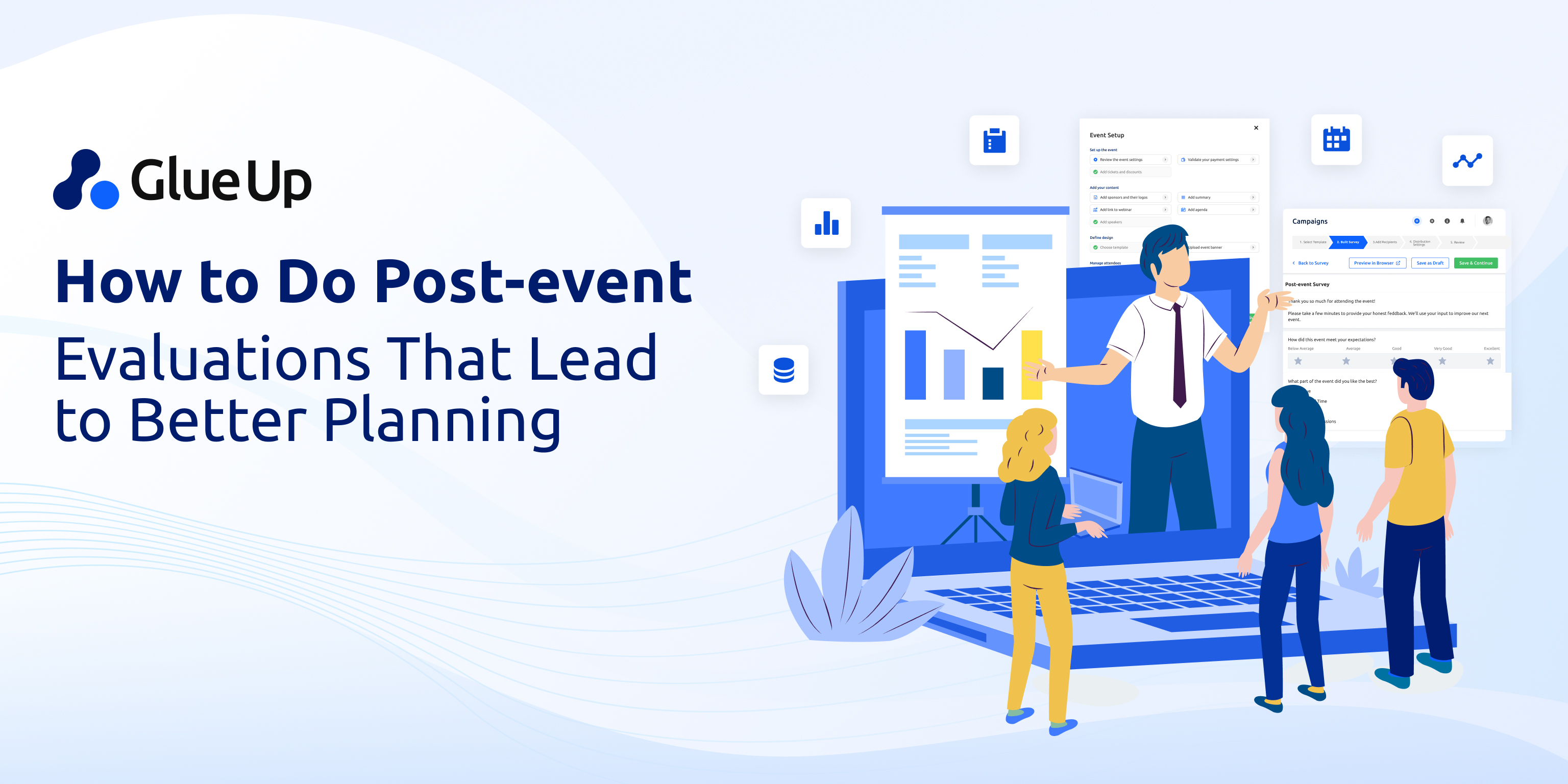
It’s the morning after your annual conference. The hotel ballroom is empty, sponsor banners have come down, and the buzz from networking still lingers. Yet if you’re the event organizer, your focus shifts almost immediately. Not to celebrating what just happened, but to asking the one question that defines whether your event was truly successful: what now?
This is where post-event evaluation steps in, as the engine of continuous improvement in event management. Too many associations and chambers treat evaluation like filling out a checklist, a box to tick before moving on to future events. The truth is sharper: events are living experiments in human engagement, and without structured evaluation, you’re flying blind.
A post-event evaluation captures more than numbers. It captures attendee feedback, sponsor sentiment, financial realities, social media engagement, and all the micro-moments that either made your event successful or revealed hidden areas for improvement. Done right, it creates an event evaluation report that guides not only the next event, but the entire strategic direction of your organization.
And in an era where members expect personalization, sponsors demand ROI, and budgets are scrutinized line by line, ignoring post-event evaluation is risky.
Key Takeaways
Post-event evaluation is the foundation of future event success. It transforms anecdotes into actionable insights, helping associations prove ROI, strengthen member engagement, and build sponsor trust.
An effective post-event evaluation blends quantitative and qualitative data. KPIs like attendance, engagement, and financial performance must be paired with attendee feedback and sponsor input to create a full picture.
Timing is everything. Sending post event surveys within 24 hours ensures sharper responses, while follow-ups at one week and one month capture reflective and lasting feedback.
Success is multi-dimensional. True evaluation considers satisfaction, engagement, sponsor ROI, financial outcomes, and alignment with long-term organizational goals.
Evaluation should be inclusive and continuous. Involving planners, sponsors, attendees, and leadership, and using tools like Glue Up’s event management platform, turns evaluation into a cycle of continuous improvement that fuels smarter, more successful future events.
Quick Reads
Event Management Platform for Modern Organizations • Glue Up
How to Measure the Success of an Event Partnership • Glue Up
Why Post-Event Evaluation Is Critical for Success and Growth
Here’s the hard truth: no matter how polished your event seemed, memory alone is deceptive. Without data, organizers lean on anecdotes: “the keynote was well-received,” “people loved the networking app.” But anecdotes don’t justify budgets or help identify areas that need work.
Post-event evaluation transforms vague impressions into actionable insights. It helps organizations:
Prove ROI: Sponsors and boards don’t want stories, they want numbers. Post event analysis delivers KPIs that show value.
Drive continuous improvement: Each event should be a prototype for the next. Without evaluation, mistakes repeat silently.
Strengthen member engagement: Attendees who see their feedback implemented return more often and recommend more freely.
Build credibility with sponsors and partners: Event evaluation reports show professionalism and accountability.
For membership-driven organizations, growth is inseparable from trust. Trust is built when members feel heard, when sponsors see measurable outcomes, and when leadership sees events contributing to long-term strategy. That’s why post-event evaluation is existential.
What Is a Post-Event Evaluation?
At its core, a post-event evaluation is a structured review of your event’s performance, an evidence-based assessment of how well your event aligned with goals, satisfied stakeholders, and delivered measurable value.
But it’s more than a stack of surveys. It’s a multi-dimensional process:
Quantitative: Attendance rates, budget performance, app engagement, session ratings, Net Promoter Score.
Qualitative: Attendee stories, open-ended feedback, staff reflections, sponsor sentiments.
Behavioral: Post-event digital behavior: who downloads slides, opens follow-up emails, joins your community platform.
Comparative: Benchmarks against past events or industry averages.
Think of it as a hybrid between a scientific experiment and a strategic debrief. You’re not just asking what happened? but also why did it happen? and how do we improve?
With Glue Up’s event management tools and event apps, these layers of data converge into one ecosystem. Instead of juggling spreadsheets, CRMs, and social feeds, you get an integrated event evaluation report that actually tells a story.
Key Objectives of Post-Event Evaluation
Why go through the effort? Because evaluation serves distinct objectives that link directly to organizational success:
Identify areas for improvement. Which logistics failed? Which sessions underperformed? Which networking formats fell flat?
Extract valuable insights. What did attendees love? Where did they engage most? Which sponsors saw real traffic?
Assess the event against KPIs. Did registrations meet targets? Did sponsors renew? Did costs align with budgets?
Demonstrate accountability. Boards, sponsors, and members expect transparency. Evaluation proves your professionalism.
Build a playbook for future events. Every evaluation compound, making each event smarter, sharper, and more aligned with strategy.
Done right, post-event evaluation shapes the future.
Steps to Conduct a Post-Event Evaluation
Conducting a post-event evaluation isn’t complicated, but it requires rigor. Think of it as a cycle:
Define success before the event. What does “successful” mean? High attendance? Strong sponsor ROI? New member signups? Without pre-defined KPIs, evaluation drifts.
Collect data quickly. Post event surveys should go out within 24 hours. Attendance logs, app analytics, and social media engagement should be exported immediately.
Combine quantitative and qualitative. Numbers without context are sterile. Comments without numbers lack credibility. The mix reveals truth.
Debrief with stakeholders. Bring your team, sponsors, and key volunteers together. Encourage brutal honesty. This isn’t a victory lap; it’s a laboratory.
Create the event evaluation report. Build a narrative: what worked, what failed, what’s next.
Close the loop. Share insights back to attendees (“You asked for shorter sessions, we heard you”) to reinforce trust.
With Glue Up, much of this cycle is automated. Surveys deploy instantly, data flows into dashboards, and KPIs can be visualized without weeks of manual reporting.
Key Metrics to Track
Metrics are the skeleton of evaluation, but they need to be chosen wisely. Some to prioritize:
Attendance vs. registration rate: How many who registered actually showed up?
Session engagement: Ratings, poll responses, Q&A participation.
Sponsor ROI: Leads collected, booth traffic, digital impressions.
Attendee feedback scores: NPS, satisfaction ratings, qualitative comments.
Financial performance: Budget variance, revenue margin, ROI.
Post-event digital engagement: Content downloads, email clicks, app logins post-event.
Social media engagement: Mentions, shares, reach during and after the event.
Tracking these metrics are identifying areas that can lift future events from good to unforgettable.
Tools for Effective Post-Event Evaluation
Relying on spreadsheets and email alone isn’t sustainable. Today’s organizers use a mix of:
Event apps for real-time surveys and attendee interactions.
CRM integrations for sponsor lead tracking and attendee lifecycle management.
Analytics dashboards that centralize KPIs, feedback, and financials.
AI copilots like Glue Up’s, which turn raw numbers into actionable insights.
The real advantage? Speed. Instead of waiting weeks, you can produce an effective post-event evaluation report in hours, while insights are still fresh and relevant.
When Should a Post-Event Survey Be Sent?
Timing is everything. The most effective surveys go out within 24 hours while memories are sharp.
Day 1: Quick, mobile-friendly survey focused on immediate impressions.
Week 1: A deeper follow-up for reflective insights (“What would you change?”).
Month 1: Check on longer-term impact (“Have you applied anything from the event?”).
This cadence respects the attendee’s time while capturing both instant reactions and lasting reflections.
What Questions Should Be in a Post-Event Survey?
Keep it short, sharp, and human. Five core questions suffice:
How satisfied were you overall?
What did you find most valuable? (content, networking, logistics, sponsors)
What could we improve?
How likely are you to recommend this event? (NPS)
Any other thoughts or feedback?
Optional: ask about specific features like event apps, session formats, or networking experiences.
The goal isn’t to interrogate attendees, it’s to listen.
How Do You Measure the Success of an Event?
Success is multidimensional:
Satisfaction: Attendees felt their time was well spent.
Engagement: Strong social media presence, lively Q&A, networking matches made.
Financial performance: Balanced budgets, strong ROI.
Strategic alignment: Did the event contribute to member retention, sponsor renewals, or organizational goals?
This is why post-event evaluation is so powerful, it reframes success beyond vanity metrics, anchoring it in key performance indicators (KPIs) that align with your mission.
Who Should Be Involved in Post-Event Evaluation?
Evaluation shouldn’t be a lonely exercise. The circle should include:
The planning team, they know the behind-the-scenes story.
Sponsors and exhibitors to gauge ROI and build trust.
Speakers and facilitators for program feedback.
Attendees, their voice is the heartbeat of evaluation.
Board and leadership to connect findings to strategy.
Bringing diverse voices ensures evaluation isn’t biased by one perspective.
The Blueprint for Future Events
Skipping post-event evaluation is like building a house without checking the foundation. You might get away with it once, but eventually, cracks appear.
Every survey completed, every metric analyzed, every post event analysis written is more than administrative work, it’s a strategic act of stewardship. It proves to members their feedback matters. It shows sponsors that ROI isn’t rhetoric. It tells leadership that events are engines of growth.
And with Glue Up’s event management tools, you transform it into a living, breathing cycle of continuous improvement that makes each event sharper, more successful, and more aligned with your organization’s mission.
Post-event evaluation isn’t the end of an event. It’s the beginning of the next one.



